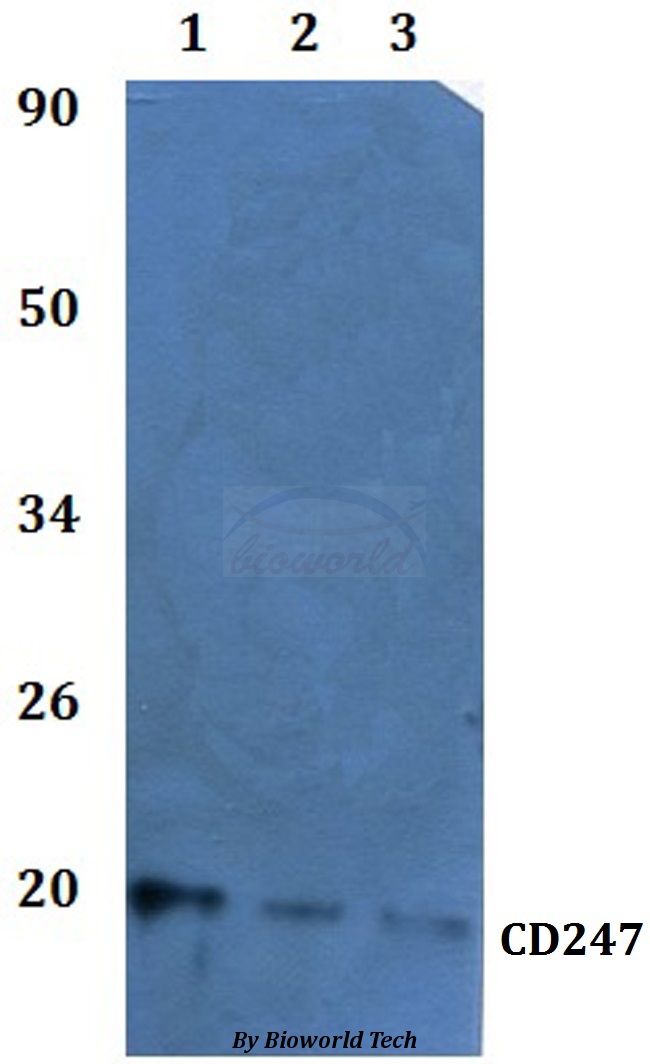Product Name :
CD3 ζ polyclonal antibody Background :
The T cell antigen receptor (TCR) recognizes foreign antigens and translates such recognition events into intracellular signals that elicit a change in the cell from a dormant to an activated state. Much of this signaling process can be attributed to a multisubunit complex of proteins that associates directly with the TCR. This complex has been designated CD3 (cluster of differentiation 3). It is composed of five invariant polypeptide chains that associate to form three dimers: a heterodimer of gamma and epsilon chains (γε), a heterodimer of delta and epsilon chains (∂ε) and a homodimer of two zeta chains (ζζ) or a heterodimer of zeta and eta chains (ζη). The ζ and η chains are encoded by the same gene but differ in their carboxyl-terminal ends due to an alternative splicing event. The γ, ε and δ chains each contain a single copy of a conserved immunoreceptor tyrosine-based activation motif (ITAM). In contrast, the ζ chain contains three consecutive copies of the same motif. Phosphorylated ITAMs act as docking sites for protein kinases such as ZAP-70 and Syk and are also capable of regulating their kinase activity. The crystal structure of the ZAP-70 SH2 domains bound to the ζ chain ITAMs has been solved. Product :
Rabbit IgG, 1mg/ml in PBS with 0.02% sodium azide, 50% glycerol, pH7.2 Storage&Stability :
Store at 4°C short term. Aliquot and store at -20°C long term. Avoid freeze-thaw cycles. Specificity :
CD247 polyclonal antibody detects endogenous levels of CD247 protein. Immunogen :
A synthetic peptide corresponding to residues in Human CD247. Conjugate :
Unconjugated Modification :
Unmodification
CD3 ζ polyclonal antibody Background :
The T cell antigen receptor (TCR) recognizes foreign antigens and translates such recognition events into intracellular signals that elicit a change in the cell from a dormant to an activated state. Much of this signaling process can be attributed to a multisubunit complex of proteins that associates directly with the TCR. This complex has been designated CD3 (cluster of differentiation 3). It is composed of five invariant polypeptide chains that associate to form three dimers: a heterodimer of gamma and epsilon chains (γε), a heterodimer of delta and epsilon chains (∂ε) and a homodimer of two zeta chains (ζζ) or a heterodimer of zeta and eta chains (ζη). The ζ and η chains are encoded by the same gene but differ in their carboxyl-terminal ends due to an alternative splicing event. The γ, ε and δ chains each contain a single copy of a conserved immunoreceptor tyrosine-based activation motif (ITAM). In contrast, the ζ chain contains three consecutive copies of the same motif. Phosphorylated ITAMs act as docking sites for protein kinases such as ZAP-70 and Syk and are also capable of regulating their kinase activity. The crystal structure of the ZAP-70 SH2 domains bound to the ζ chain ITAMs has been solved. Product :
Rabbit IgG, 1mg/ml in PBS with 0.02% sodium azide, 50% glycerol, pH7.2 Storage&Stability :
Store at 4°C short term. Aliquot and store at -20°C long term. Avoid freeze-thaw cycles. Specificity :
CD247 polyclonal antibody detects endogenous levels of CD247 protein. Immunogen :
A synthetic peptide corresponding to residues in Human CD247. Conjugate :
Unconjugated Modification :
Unmodification
-
 Western blot (WB) analysis of CD247 polyclonal antibody at 1:500 dilution Line1:Jurkat whole cell lysate Line2:PC12 whole cell lysate Line3:sp20 whole cell lysate
Western blot (WB) analysis of CD247 polyclonal antibody at 1:500 dilution Line1:Jurkat whole cell lysate Line2:PC12 whole cell lysate Line3:sp20 whole cell lysate
Bioworld Biotech only provide peptides for our antibodies and do not provide additional peptide customization services.
Price/Size :
USD 368/1mg/vial
Tips:
For phospho antibody, we provide phospho peptide(0.5mg) and non-phospho peptide(0.5mg).Describe :
Blocking peptides are peptides that bind specifically to the target antibody and block antibody binding. These peptide usually contains the epitope recognized by the antibody. Antibodies bound to the blocking peptide no longer bind to the epitope on the target protein. This mechanism is useful when non-specific binding is an issue, for example, in Western blotting (WB) and Immunohistochemistry (IHC). By comparing the staining from the blocked antibody versus the antibody alone, one can see which staining is specific; Specific binding will be absent from the western blot or IHC performed with the neutralized antibody.Formula:
Synthetic peptide was lyophilized with 100% acetonitrile and is supplied as a powder. Reconstitute with 0.1 ml DI water for a final concentration of 10 mg/ml.The purity is >90%,tested by HPLC and MS.
Storage:
The freeze-dried powder is more stable. For short time at 2-8°C. For long term storage store at -20°C.
Note :
This product is for research use only (RUO only). Not for use in diagnostic or therapeutic procedures.
 CD3 ζ polyclonal antibody
CD3 ζ polyclonal antibody  Datasheet
Datasheet COA
COA MSDS
MSDS SHIP
SHIP